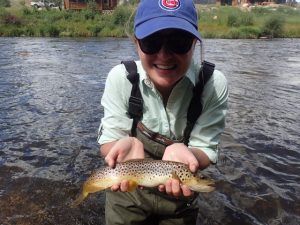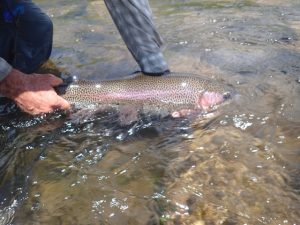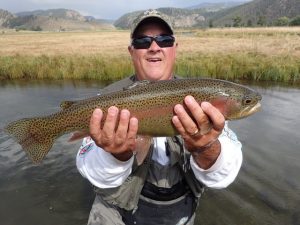Well, another season of Taylor River fly fishing at Wilder is winding down. The leaves have mostly fallen, the river has dropped to winter levels and snow is blanketing the mountains.
In addition to the normal signs of October, this season we have something that I’ve never seen while Taylor River fly fishing at Wilder: hundreds if not thousands of Kokanee salmon. Over the past several years, we have had salmon at Wilder but they usually enter in mid October in much smaller numbers than they have this year. This season, they came in early September in big numbers and now there are well over 1000 in the river at Wilder. Why these fish enter the Taylor at all is somewhat of a mystery. I had a long conversation with the Department of Wildlife last week and they are also puzzled. There seem to be 2 possibilities. Either these represent the small percentage of Salmon that either get lost or are looking for new territory or there is a chance that a quantity of stocked fingerlings from the Taylor Reservoir actually went through the dam and wound up going down to Blue Mesa and are trying to return to spawn. Regardless, we have plenty of Salmon. How this will effect the trout fishery is unclear. My concern is that the Salmon may displace the Brown trout off of their redds and interrupt their spawning. I guess we will see what happens. The good news is that the Gunnison and East Rivers have plenty of Salmon and the trout seem to be doing just fine.
 Salmon aside, Taylor River fly fishing has been on fire for the last couple of weeks as the fish are eating as much as possible before the long, hard winter arrives. The river level has dropped from 380 CFS to winter flow levels of about 180 CFS. Hatches, like always, have been prolific on cloudy afternoons and last week we saw lots of BWO’s, PMD’s, Gray Drakes and Fall Caddis in that magical period between 12 and 4 pm. During this time a size 20 BWO seems to work the best and on the right day, many fish can be hooked in a short period of time. Because the Salmon do at least temporarily displace the trout, my advice is to fish runs with less Salmon. Typically the Salmon are congregated where there is good, clean, fine gravel so look for runs with larger rocks and less gravel.
Salmon aside, Taylor River fly fishing has been on fire for the last couple of weeks as the fish are eating as much as possible before the long, hard winter arrives. The river level has dropped from 380 CFS to winter flow levels of about 180 CFS. Hatches, like always, have been prolific on cloudy afternoons and last week we saw lots of BWO’s, PMD’s, Gray Drakes and Fall Caddis in that magical period between 12 and 4 pm. During this time a size 20 BWO seems to work the best and on the right day, many fish can be hooked in a short period of time. Because the Salmon do at least temporarily displace the trout, my advice is to fish runs with less Salmon. Typically the Salmon are congregated where there is good, clean, fine gravel so look for runs with larger rocks and less gravel.
 This time of year, Taylor River fly fishing typically consists of cold mornings and the fishing is generally a bit slow; however, we have had good success fishing a size 12 para Adams on top and a #16 Bead or Tung head Pheasant tail on the bottom. Until noon, not many fish will eat the dry but lots will eat the dropper. Towards noon, you will start to see bugs and a few fish rising. At this time you can begin to expect action on the dry. As the hatch becomes more prolific and more fish are rising, this is the time to size down your dry, tie on 6x tippet and a small BWO and have at it. While Taylor River fly fishing, I always like to have several Blue Winged patterns in my vest as on certain days, certain patterns work best. One thing I have found is that a dark wing works much better than a light wing for this hatch regardless of what the body looks like. If you are getting refusals, don’t be afraid to experiment with different patterns. First of all I like to match the size, then shape and then color. Sometimes just a slight difference in the fly will make all of the difference to the fish.
This time of year, Taylor River fly fishing typically consists of cold mornings and the fishing is generally a bit slow; however, we have had good success fishing a size 12 para Adams on top and a #16 Bead or Tung head Pheasant tail on the bottom. Until noon, not many fish will eat the dry but lots will eat the dropper. Towards noon, you will start to see bugs and a few fish rising. At this time you can begin to expect action on the dry. As the hatch becomes more prolific and more fish are rising, this is the time to size down your dry, tie on 6x tippet and a small BWO and have at it. While Taylor River fly fishing, I always like to have several Blue Winged patterns in my vest as on certain days, certain patterns work best. One thing I have found is that a dark wing works much better than a light wing for this hatch regardless of what the body looks like. If you are getting refusals, don’t be afraid to experiment with different patterns. First of all I like to match the size, then shape and then color. Sometimes just a slight difference in the fly will make all of the difference to the fish.
After around 4 pm, the action slows down and fish return to the bottom of the river where they can be enticed with a nymph or streamer but the dry fishing is generally over for the day.
There are 2 other techniques that can work well at this time of year. One is to fish Streamers, swinging them through the runs and along the banks and the other is to fish egg patterns through and behind the large pods of Salmon. Occasionally large trout lay behind the Salmon to eat their deposited eggs. Many times these trout can be sighted and cast to. It is not pretty fishing but an indicator, split shot and an egg pattern can produce some large fish.
As we enter late fall and winter, the hatches will fade away and Midges will constitute the majority of what the fish will eat for the coming months. Small Midge dries and droppers on light tippets will work well until there is to much ice to fish. On any day there is always the possibility of a hatch whether Midges or BWO’s, so be observant and you may have some excellent cold weather dry fly fishing.
 The Dream Stream is doing great. There are some wild Browns spawning on clean gravel and fish populations are quite high. This does not mean easy fishing as the trout have become very selective and spooky after a long summer. Mid to late mornings there have been some good BWO hatches and fish will be seen rising for them. 6x is too light for some of these large fish so I recommend using 4x and cutting it at a sharp angle to be able to thread it through small hook eyes. Not the best scenario if you hook a 9 lb rainbow on 6x… you have almost zero chance of landing it. With 5x your odds are better but still not that great. I have found that with 4x most trout can be subdued without breaking the line.
The Dream Stream is doing great. There are some wild Browns spawning on clean gravel and fish populations are quite high. This does not mean easy fishing as the trout have become very selective and spooky after a long summer. Mid to late mornings there have been some good BWO hatches and fish will be seen rising for them. 6x is too light for some of these large fish so I recommend using 4x and cutting it at a sharp angle to be able to thread it through small hook eyes. Not the best scenario if you hook a 9 lb rainbow on 6x… you have almost zero chance of landing it. With 5x your odds are better but still not that great. I have found that with 4x most trout can be subdued without breaking the line.
Water is low and clear and the fish are very spooky. Your best bet is to move very slowly along the banks and concentrate on soft presentations and fairly long casts. The fish that spook in the “tail outs” of the pools will run upstream to hide and your best chances of catching one is in the faster currents at the head of the runs. Take your time to work into position and try to locate rising fish. Occasionally a Hopper will work but generally the fish are looking for very small bugs and will ignore larger offerings. Less casting and more observation leads to more success than non stop casting. Many of these fish can be spotted and fished to and that is always my first choice rather than just random casting. Of course, if the fish are hidden or you see no surface activity, blind casting can work. Concentrate on the foam lines and current seams with very soft casts and you will be rewarded. I cannot emphasize enough how important presentation is here. A cast that hits the water hard not only has a very low chance of fooling a fish, it also has a very high chance of spooking every fish in the pool, requiring the angler to move to the next pool. My favorite technique if there are rising fish is to stealthily get into casting position and wait until you see the fish start rising again. If they do not, you know that you have spooked them and you might consider fishing a dropper or moving on. However if they resume rising again, you are now in position to make a good cast and drift. Take your time and be patient. Over casting is a sure way to spook the fish.
 The ponds not only have some lunkers, at times they can be easy to catch. Again, I emphasize a soft presentation and if this is accomplished, these trout can be caught on a variety of flies. We have had success with Para Adams, Midges, Beetle patterns, Hoppers and Ants. A little breeze is always best and I prefer it to a mirror still pond. My favorite technique is to walk slowly along the edges of the pond and look for cruisers. One never really knows how close one can cast to the fish without spooking it so I advise starting with a cast about 15 feet in front of the fish and see how he reacts. If that is too far for him to see it, gradually make your casts closer and closer and see what works. If the fish are laying low, then changing to a streamer or small nymph can work. I like to slow crawl an olive Wooly Bugger and we have had great results doing this. Cast, strip out your slack and just let the fly sink. While it is sinking watch your fly line carefully as oftentimes the fish will eat the fly on the drop. The only indication that you will have is that your line might start to straighten out or move slightly to one side. If you see this, set the hook immediately because the fish already has your fly. If not, make 2 or 3 fairly aggressive strips and then let it sink again. Repeat until you can see your fly, then recast into a different area.
The ponds not only have some lunkers, at times they can be easy to catch. Again, I emphasize a soft presentation and if this is accomplished, these trout can be caught on a variety of flies. We have had success with Para Adams, Midges, Beetle patterns, Hoppers and Ants. A little breeze is always best and I prefer it to a mirror still pond. My favorite technique is to walk slowly along the edges of the pond and look for cruisers. One never really knows how close one can cast to the fish without spooking it so I advise starting with a cast about 15 feet in front of the fish and see how he reacts. If that is too far for him to see it, gradually make your casts closer and closer and see what works. If the fish are laying low, then changing to a streamer or small nymph can work. I like to slow crawl an olive Wooly Bugger and we have had great results doing this. Cast, strip out your slack and just let the fly sink. While it is sinking watch your fly line carefully as oftentimes the fish will eat the fly on the drop. The only indication that you will have is that your line might start to straighten out or move slightly to one side. If you see this, set the hook immediately because the fish already has your fly. If not, make 2 or 3 fairly aggressive strips and then let it sink again. Repeat until you can see your fly, then recast into a different area.
If you hook one of these monsters make sure to let him run. Do not try to stop him or you will hear the sickening snap of your tippet breaking.
 Overall it has been a wonderful season of Taylor River fly fishing at the Wilder. We have had some excellent days of fishing, fantastic weather and plenty of good company on the water. I can think of more than a few folks who caught their first trout out here and the smiles on their faces were memorable. I enjoyed my time with all owners and guests and look forward to another fun season next year.
Overall it has been a wonderful season of Taylor River fly fishing at the Wilder. We have had some excellent days of fishing, fantastic weather and plenty of good company on the water. I can think of more than a few folks who caught their first trout out here and the smiles on their faces were memorable. I enjoyed my time with all owners and guests and look forward to another fun season next year.









